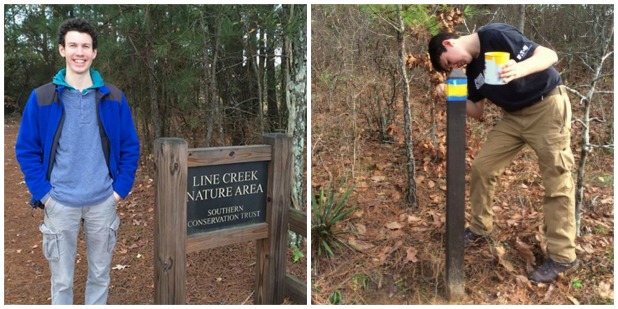Imagine what impact 100,000,000 foot prints could make in your neighborhood if they were not on the street or paved path. That is what the estimated 25,000 visitors make at the popular Line Creek Nature Area each year walking on the natural surface trails and cutting through the woods making new social trails.
Those impacts have had a significant cumulative effect, resulting in loss of an acre of protective forest and vegetation over the last 10 years and increasing soil erosion and pollution runoff into the creek, a tributary to the Flint River and source of drinking water for Fayette County residents.
Trail erosion and controlling visitor impacts are long-standing maintenance issues at the Line Creek Nature Area. The Southern Conservation Trust contracted in 2009 a professional trail construction consultant from the Southern Off-Road Bicycle Association using a State of Georgia Recreational Trail Program grant to propose solutions to the visitor impacts. The trail consultant reviewed the existing trails, erosion problems and visitor behavior to recommend specific trail closure, construction and control measures including adding trail signs.
As a result of this survey, the Mule Rock trail was constructed and several social trails closed as an Eagle Scout service project in 2010. However, the social trails closed using only natural materials scattered over the ground were reopened over time by visitors. Erosion has continued on the Ridge trail because no water bars were installed on the Ridge trail.
Enter Eagle Scout Sean McCarthy from Boy Scout Troop 2193 in Sharpsburg, who approached the Southern Conservation Trust last summer looking for a fourth significant conservation project for his Hornaday Award application.
The Hornaday Award program was begun in 1914 by Dr. William T. Hornaday, director of the New York Zoological Park and founder of the National Zoo in Washington, D.C. Dr. Hornaday was an active and outspoken champion of natural resource conservation and a leader in saving the American bison from extinction. The purpose of this award program is to encourage learning by the participants and to increase public awareness about natural resource conservation. Today, only about 25 Boy Scouts earn this national level recognition each year, and only 1,200 have been awarded since the program began.
Sean recognized after a visit to Line Creek that the greatest conservation issue was to tackle the soil erosion problem caused by the social trails and deforestation that leads to runoff water pollution. After attending a trail construction workshop, conducting considerable research into best practices at other parks and consulting with his project advisor, Dennis Chase, he made a comprehensive project proposal employing multiple strategies to address soil erosion in the park.
Sean’s project is now complete after working with youth and adult volunteers from his troop and a Cub Scout Pack over five work days and several hundred hours of labor. The worst of the social trails was closed off with fencing. Permanent trail identification to help visitors was improved by adding colored blazes, replacing trail signs and installing new signs where markers were missing. Informational signs were added to the North and South trail entries and elsewhere to improve safety and to educate visitors about “Leave No Trace” conservation practices including staying on the marked trails, removing trash, and cleaning up after their pets. Five water bars were installed to arrest further soil erosion on the Ridge trail. The volunteers also recovered the damaged areas to allow the return of forest vegetation.
The Southern Conservation Trust is thankful for Sean for volunteering to organize and lead this significant community service conservation project at the Line Creek Nature Area. We see the long term positive benefits of his project will lead to a better visitor experience with an improved forest habitat and a cleaner river environment.






